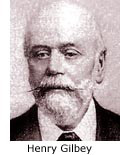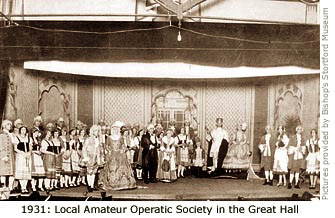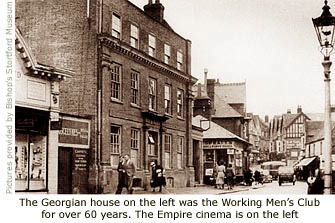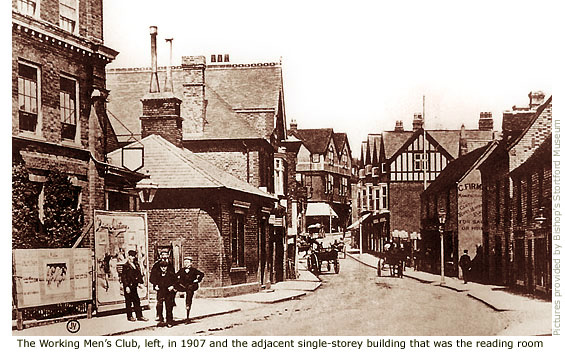|
After its beginnings in small premises behind the Corn Exchange (See Guide 2), the Working Men’s Club moved, in 1873, to a large Georgian house in South Street previously owned by the Gee family. The site is now occupied by No’s 12a–16b.
 It was bought by Henry Parry Gilbey – brother of Sir Walter Gilbey – who then rented it to the Club for a nominal amount. He also became the club’s first president, which at that time, because of the Gilbey family’s political persuasion, was called the Liberal Club. It was bought by Henry Parry Gilbey – brother of Sir Walter Gilbey – who then rented it to the Club for a nominal amount. He also became the club’s first president, which at that time, because of the Gilbey family’s political persuasion, was called the Liberal Club.
With its many rooms, members were offered a wide range of activities, including lectures, concerts and drawing classes. The top floor housed a library containing 3,000 books, as well as a reading room that overlooked the garden and a field opening onto Portland Road. By 1913 both reading room and library, by now boasting 3,730 books, was relocated in the lodge house that stood alongside the club.
|
|
The Working Men’s Club was a success from the start, but it soon became apparent that more space was needed for academic studies and entertainment. In 1879, Henry Parry Gilbey, along with his brothers Walter and Alfred Gilbey and the club’s Vice President J. L. Glasscock, journeyed to Kilburn in London to view the old Agricultural Hall that was due for demolition. Proving ideal for the club's needs, the large wooden structure was subsequently purchased, dismantled and brought to Bishop’s Stortford where it was re-erected on land behind the club.
 Its numerous lobbies, anti-rooms and chambers were soon put to good use and a stage was built at one end for entertainment purposes. Because of its immense size (800 people could be seated) townspeople labelled it the Great Hall, and for the next fifty years it served most great occasions in the town’s life. It also catered for band concerts, trade exhibitions, travelling theatre, municipal meetings, midget circuses and operatic events – even the famous Carl Rose Opera Company played here. Leisure facilities included billiards, indoor bowling and ice-skating. It was the annual venue for the Hunt Ball and Firemans Ball, and for 14 years the meeting place of the Salvation Army (See Guide 14). Up until 1903 it was also used as the County Court House every two months. Its numerous lobbies, anti-rooms and chambers were soon put to good use and a stage was built at one end for entertainment purposes. Because of its immense size (800 people could be seated) townspeople labelled it the Great Hall, and for the next fifty years it served most great occasions in the town’s life. It also catered for band concerts, trade exhibitions, travelling theatre, municipal meetings, midget circuses and operatic events – even the famous Carl Rose Opera Company played here. Leisure facilities included billiards, indoor bowling and ice-skating. It was the annual venue for the Hunt Ball and Firemans Ball, and for 14 years the meeting place of the Salvation Army (See Guide 14). Up until 1903 it was also used as the County Court House every two months.
When Henry Parry Gilbey died in 1905 the premises and land, as part of his estate, was to be sold at public auction. The club’s trustees submitted an offer but the trustees responsible for Gilbey’s Estate negotiated over the price, the emphasis put on the value of the land and not the buildings. An agreement was finally reached and £1,625 was paid, securing the future of the Club and the Great Hall.
Four years after Cecil Rhodes died in 1902 a Rhodes Memorial Hall was proposed, the president of the club, Sir John Barker, suggesting it should be combined with the Great Hall. Nothing came of the idea although a bust of Cecil Rhodes, created by Henry Pegrum in 1902, was kept on the premises for some time.
To celebrate the opening of St Joseph’s Church in 1906, a luncheon was held at the hall attended by the Rector of St Joseph’s, Oliver Vassall-Phillips, Cardinal Bourne, and 200 dignitaries and friends. That same year part of the hall’s frontage in Portland Road was sold off as building plots for £412.
|
|
During the First World War (1914–18) both hall and club were used as a billet and canteen for soldiers stationed in the town, but the iron railings that ornamented the outside of the building somehow managed to survive requisition to aid the war effort. Then in 1920 the Council, after being given the club’s forecourt for dedication to the Highway, insisted the railings be removed. The club complied and they were later sold at a Sworder’s auction sale.
 From the very beginning, club membership included the town’s most notable names: Henry Parry Gilbey and his brothers Walter and Albert; Tresham Gilbey; Sir John Barker; Herbert Sworder; Henry Sparrow; Arthur Boardman; Joe Brazier; Alfred Slapps Barrett, and J.L. Glasscock. Mr Glasscock is renowned for being one of the town’s foremost historians, and Slapps Barrett was a club member for fifty years. From the very beginning, club membership included the town’s most notable names: Henry Parry Gilbey and his brothers Walter and Albert; Tresham Gilbey; Sir John Barker; Herbert Sworder; Henry Sparrow; Arthur Boardman; Joe Brazier; Alfred Slapps Barrett, and J.L. Glasscock. Mr Glasscock is renowned for being one of the town’s foremost historians, and Slapps Barrett was a club member for fifty years.
By the 1920s the Great Hall had become an institution, but in rapidly changing times townspeople began to find alternative places to socialise, including the newly opened Long’s ballroom in North Street. The effect on the Great Hall was dramatic: by 1925 the club’s membership was down to 203 and it had to be subsidised by the club.
In the 1930s, commercial interest in the land on which the club and hall stood led to its sale, and the subsequent building of the present Working Men’s Club in (Lower) South Street (See Guide 14). Both the Great Hall and club were demolished around 1937.
In June of that year a public meeting was held to decide how to commemorate the forthcoming coronation of George VI. But the suggestion that a Queen’s Hall be built to replace the Great Hall was greeted with very little enthusiasm and the idea dropped. No trace of the Great Hall now exists, its former site replaced long ago by new development. MORE PICTURES
|




 Its numerous lobbies, anti-rooms and chambers were soon put to good use and a stage was built at one end for entertainment purposes. Because of its immense size (800 people could be seated) townspeople labelled it the Great Hall, and for the next fifty years it served most great occasions in the town’s life. It also catered for band concerts, trade exhibitions, travelling theatre, municipal meetings, midget circuses and operatic events – even the famous Carl Rose Opera Company played here. Leisure facilities included billiards, indoor bowling and ice-skating. It was the annual venue for the Hunt Ball and Firemans Ball, and for 14 years the meeting place of the Salvation Army (See Guide 14). Up until 1903 it was also used as the County Court House every two months.
Its numerous lobbies, anti-rooms and chambers were soon put to good use and a stage was built at one end for entertainment purposes. Because of its immense size (800 people could be seated) townspeople labelled it the Great Hall, and for the next fifty years it served most great occasions in the town’s life. It also catered for band concerts, trade exhibitions, travelling theatre, municipal meetings, midget circuses and operatic events – even the famous Carl Rose Opera Company played here. Leisure facilities included billiards, indoor bowling and ice-skating. It was the annual venue for the Hunt Ball and Firemans Ball, and for 14 years the meeting place of the Salvation Army (See Guide 14). Up until 1903 it was also used as the County Court House every two months. From the very beginning, club membership included the town’s most notable names: Henry Parry Gilbey and his brothers Walter and Albert; Tresham Gilbey; Sir John Barker; Herbert Sworder; Henry Sparrow; Arthur Boardman; Joe Brazier; Alfred Slapps Barrett, and J.L. Glasscock. Mr Glasscock is renowned for being one of the town’s foremost historians, and Slapps Barrett was a club member for fifty years.
From the very beginning, club membership included the town’s most notable names: Henry Parry Gilbey and his brothers Walter and Albert; Tresham Gilbey; Sir John Barker; Herbert Sworder; Henry Sparrow; Arthur Boardman; Joe Brazier; Alfred Slapps Barrett, and J.L. Glasscock. Mr Glasscock is renowned for being one of the town’s foremost historians, and Slapps Barrett was a club member for fifty years.